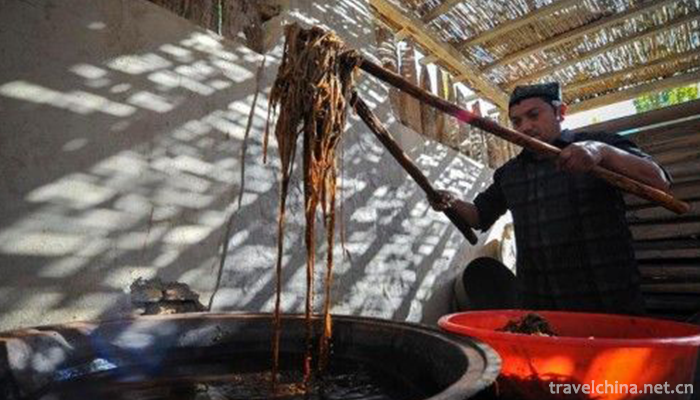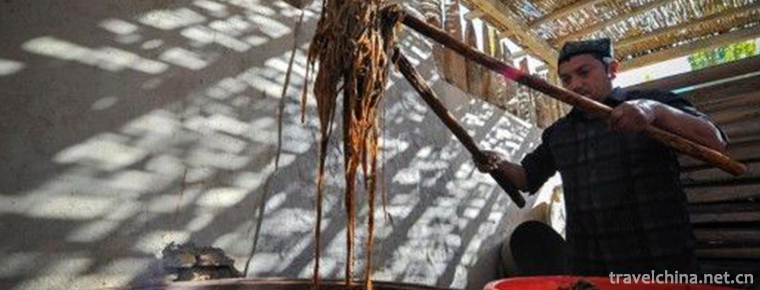Uygur Mulberry Paper Making Skills
Uygur Mulberry Paper Making Skills
Uygur mulberry paper making skills, Xinjiang local traditional handicraft, one of the national intangible cultural heritage.
Uygur mulberry paper takes mulberry branch endothelium as raw material, mulberry branch endothelium is sticky, smooth and delicate, easy to process, after exploitation, soaking, pot boiling, pounding, fermentation, filtration, moulding, drying, rough grinding and other processes can be made into mulberry paper. Paper is divided into three grades: high, medium and low, and has a wide range of uses.
In 2006, Uygur mulberry paper making skills were listed in the national intangible cultural heritage list, project number_-70.
historical origin
Mulberry paper accurately records the Tang Dynasty. According to the records, in 1908, Stein, an Englishman, found a book made of mulberry paper in a Tang Dynasty monastery in Mazatag Mountain, 100 kilometers north of Hotan City, which recorded the situation that the monastery bought paper locally. This shows that there was mulberry paper industry in Hetian area at that time.
Gu Wenjian of the Song Dynasty wrote in his "Miscellaneous Records of Negative Samples". It is recorded that the only mulberry paper in China today is mulberry paper. This also proves that in the Song Dynasty, in the Western Liao Dynasty, Hetian was famous for making paper from mulberry bark, which became an important family handicraft for local people.
In the mid-14th century, mulberry paper production technology was introduced from Hotan to Turpan, which made greater progress. By the Ming and Qing Dynasties, the communication between the Central Plains and the Western Regions was frequent, and mulberry paper from the Western Regions was also used by people in the Central Plains. In the fifth chapter of Wu Jingzi's Outside History of Confucianism in the Qing Dynasty, it was written: "Two talents were pulled over, one under the dates, wrapped in mulberry paper; when you looked for it, there were altogether 52 silver." It shows that mulberry paper was very popular in the Ming and Qing Dynasties and was widely used.
In ancient times, mulberry paper was not only used as ordinary paper, but also used for advanced mounting, umbrella making, traditional Chinese medicine wrapping, fan making and so on. In the early 20th century, mulberry paper was also briefly used to print local currency in Hotan. The remaining mulberry paper documents of the Qing Dynasty and mulberry paper banknotes of the National Period also prove that mulberry paper was widely used in Xinjiang in the past.
Technological characteristics
Mulberry paper is light brown, the craft is exquisite mulberry paper is translucent, very thin. The local government books and books formed during the Qing Dynasty and the Republic of China in Southern Xinjiang basically use mulberry paper as a page, and the appearance and feel are only slightly rougher than those of the mainland ancient books. Mulberry paper has been used for advanced mounting, umbrella making, basket making, artillery drawing, traditional Chinese medicine wrapping, fan making and so on in ancient times.
Paper is divided into four grades according to its quality: first, second-class thick and white, third and fourth-class thin and soft. Refined mulberry paper or Uygur Girls Embroidered Hat necessary accessories. When embroidering the cap, the warp and weft of the blank cloth should be separated from each other. After embroidering, a small paper stick rubbed with mulberry paper is inserted into the space of the blank warp and weft. The cap made by this method is flexible, soft and moderate. Mulberry paper is soft and tough. Books and books in Xinjiang in Qing Dynasty are mainly printed on high-grade mulberry paper. Banknotes printed on mulberry paper were popular in the Republic of China. Medium quality mulberry paper is generally used for packaging. For tea, candy, herbs, food, etc., mulberry paper can be used for packaging as long as the items are not too big. Coarse mulberry paper is often used to paste skylights or accessories for leather boots and so on.
Handmade mulberry paper can be divided into "raw paper" and "cooked paper". Raw paper is unprocessed yellow paper, and cooked paper is white paper after processing.
Technological process
Uygur mulberry paper takes mulberry bark as raw material, mulberry branch endothelium is sticky, the fiber is smooth and delicate, easy to process, after exploitation, soaking, pot boiling, beating, fermentation, filtration, mold entry, drying, rough grinding into mulberry paper, paper is square, about 50 centimeters long.
When making paper, the mulberry branches are soaked in water, then the dark skin of the surface is stripped, the white bark of the inner layer is taken out, and boiled in a large iron pot filled with water, stirring while boiling until the bark is cooked and soft rotted, and then added euphratine.
The cooked mulberry peel was removed and placed on a rectangular thin stone slab. The craftsman knelt in front of the slab, covered his legs with a piece of cloth, and then lifted a wooden hammer with a short handle and a long head to smash the mulberry peel. Put mulberry peel into a mud cake and put it in a barrel half buried in the ground.
Then he took a stick with a small cross on its head and put it into the barrel to stir. After a while, the mulberry pulp was stirred, and the dregs were filtered by a special sieve. Then a large wooden ladle was put into the barrel to scoop out a large spoon of pulp. Then a sand net, about 40-50 cm in size, wooden mould was placed in a small puddle to block the pulp.
The pulp is poured into the mould and stirred continuously with a wooden stick with a small cross on the head to make the pulp evenly spread on the mould. After the pulp is evenly laid, the mould is held flat and a small puddle is put where the sunshine can shine sufficiently. When the pulp is dried on the mold, what is torn off is a genuine mulberry paper.
Inheritance and Protection
Inheritance value
Xinjiang Uygur mulberry paper production technology takes mulberry tender bark as raw material. The paper has the characteristics of good toughness, strong pulling force, soft texture, strong water absorption and non-fading for thousands of years. Restoring and reconstructing ancient books is one of the professional uses of mulberry paper.
Heritage figures
Tohudibahai Tuerdi, male, Uygur, a native of Puchakchi, Moyu County, Xinjiang Uygur Autonomous Region. In May 2006, it became the first representative successor of national intangible cultural heritage projects.
protective measures
In Hotan Moyu County, Tohudi Tuerdi's hometown, a mulberry paper inheritance center has been set up to encourage the recipients of government subsidies to pass on mulberry paper making skills to the next generation, and to build a street for mulberry paper making, so that more and more mulberry paper makers can make a living by making mulberry paper at their doorsteps.
social influence
Important Exhibitions
In 2012, Xinjiang mulberry paper manufacturing technology appeared in the cultural center of Xicheng District. More than 100 paintings on mulberry paper were assembled into "Blue Indigo Gold Foil - Chinese Painting - Mulberry Paper Painting Exhibition".
Representative Works
The Uygur classics Nobitti Poetry Selection and Uygur Medicine Complete in Qing Dynasty are all made of mulberry paper.
Distribution area
Hetian mulberry paper is mainly distributed in Hetian City, Hetian County, Luopu County, Pishan County and Moyu County, among which Moyu County, Pishan County and Luopu County are the concentrated producing areas of mulberry paper.


-
1.88 Floor Sightseeing Hall of Jinmao Building
Jinmao Tower's 88th floor sightseeing hall, located in Shanghai, China, has a height of 340.1 meters and an area of 1520 square meters. It is the largest sightseeing hall in China at present. It is th
Time 2019-01-26 -
2.Laosicheng Site
Laosicheng Site is located in Laosicheng Village, Lingxi Town, more than 20 kilometers east of Yongshun County, Tujia and Miao Autonomous Prefecture, western Hunan Province
Time 2019-01-29 -
3.Buddhist music
Buddhist music, the music used by Chinese Buddhist temples and believers in religious ceremonies. Buddhism believes that music has the function of "offering" and "praising Buddha".
Time 2019-04-29 -
4.Rolling lamp
Rolling lantern is an art form of entertainment and self-enjoyment for the masses in Han folk festivals, and also a competitive performance to show the strength of villages. It is mainly prevalent in
Time 2019-05-02 -
5.Lusheng music
Lusheng is one of the core musical instruments in Miao traditional music culture. In the long history of Miao music practice, its cultural function is not limited to universal musical instruments, bec
Time 2019-05-15 -
6.Mongolian Sihu Music
Mongolian Sihu music is one of China's intangible cultural heritage. Mongolian Sihu is one of the most distinctive Mongolian musical instruments, stringed instruments.
Time 2019-06-04 -
7.Handmade Weaving Techniques of Wood Machine Cosmetics
Nanjing Yunjin wooden machine makeup and hand-weaving skills, the local traditional skills of Nanjing, Jiangsu Province, one of the national intangible cultural heritage.
Time 2019-06-07 -
8.Laozi Shandong Province
Shandong Laozi is a traditional opera art form which spreads in Shandong Province. It evolved from the ancient "lotus flower falls". Laozi instruments are mainly cymbals (commonly known as G
Time 2019-06-13 -
9.Ziyang Folk Songs
Ziyang Folk Song is the general name of traditional folk songs spread in Ziyang County, Shaanxi Province, and it is the most representative of traditional folk songs in southern Shaanxi Province. It h
Time 2019-08-16 -
10.Guan Hanqing
Guan Hanqing (before 1234) - about 1300 The original name is unknown. The word "Han Qing" is already Zhai. The Han nationality is a member of the state of Yuncheng (Shanxi province). Another
Time 2019-09-07 -
11.Chunqiu Temple
Chunqiu temple, also known as Chunqiu pool and Chunqiu Pavilion, is located in Yandian street, Xuyong county (Xuyong town), Luzhou City, Sichuan Province. It is mainly dedicated to Guan Sheng emperor. It is said that Guan Yu likes to read the biography of the left family in the spring and Autumn period, so it is named Chunqiu temple.
Time 2020-10-15 -
12.Population and nationality of Suining
At the end of 2019, the total number of household registration in Suining was 1 million 380 thousand, and the household registration population was 3 million 629 thousand, a decrease of 0.7% over the previous year, of which 1 million 4 thousand and 900
Time 2020-12-16